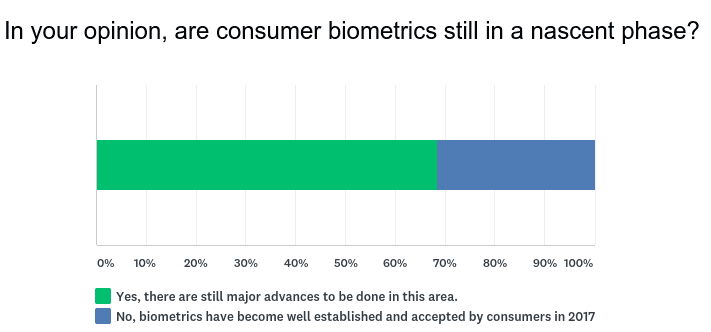In December of 2017 FindBiometrics surveyed over 200 members of its informed audience – including executives from the world’s leading biometrics companies – on topics relating to the identity technology industry over the past 12 months. The results comprise the 15th Annual FindBiometrics Year in Review.
 The FindBiometrics Year In Review survey has produced a lot of interesting results, but one of the more exciting among these is the response to Question Seven: “In your opinion, are consumer biometrics still in a nascent phase?” Roughly two thirds of respondents – 68.5 percent – said, “Yes, there are still major advances to be done in this area,” while 31.5 percent responded, “No, biometrics have become well established and accepted by consumers in 2017.”
The FindBiometrics Year In Review survey has produced a lot of interesting results, but one of the more exciting among these is the response to Question Seven: “In your opinion, are consumer biometrics still in a nascent phase?” Roughly two thirds of respondents – 68.5 percent – said, “Yes, there are still major advances to be done in this area,” while 31.5 percent responded, “No, biometrics have become well established and accepted by consumers in 2017.”

On its own, the latter statement is not a controversial one. The mobile revolution of the last several years, spearheaded by Apple’s fingerprint scanning Touch ID system, which launched on the iPhone in 2013, has been the key factor in familiarizing the mass market with biometric technology, with fingerprint sensors now a more or less standard feature on smartphones.
That having been said, consumer biometrics don’t end at fingerprint scanning on smartphones, and the majority of respondents clearly believe that this was merely the beginning. Iris recognition, for example, is still pretty novel, though it’s being championed by one of the biggest smartphone brands in the world. Meanwhile, Apple has made a big splash with the 3D facial recognition system of its iPhone X, and the rest of the industry is only just starting to respond. Even fingerprint recognition is continuing to evolve with the invention of in-display technologies.
Beyond smartphones, biometric technologies are also finding their way into more laptops and computers, smart home hub devices like the Google Home products, and even smart cars and connected cars. Meanwhile, Mastercard and Visa are both preparing for large-scale launches of biometric payment cards for this year, signalling a big shift in the payments sector. Those who believe that consumer biometrics are no longer in a nascent phase may believe that biometric authentication isn’t really going to catch on in these other areas the way it has in the mobile sector, but the bioptimist majority appears to believe all of these are growth areas. And given that most of the Year In Review respondents are within the industry or adjacent areas, it looks like a lot of people are betting on that latter.
The 15th Annual FindBiometrics Year in Review is brought to you by Leidos.
–
January 22, 2018 – by Alex Perala






Follow Us